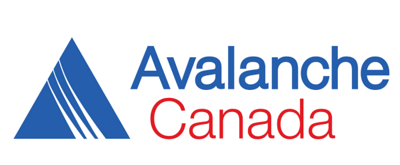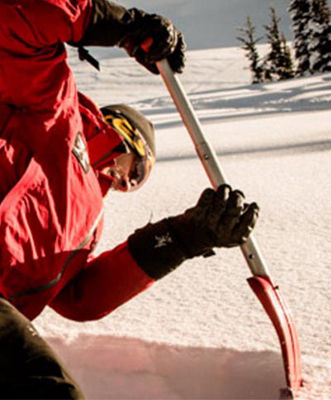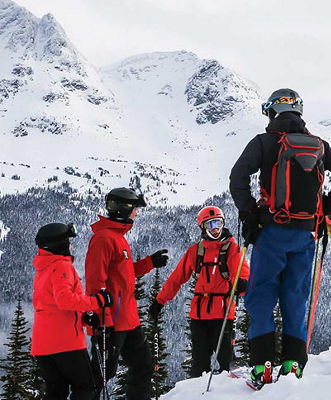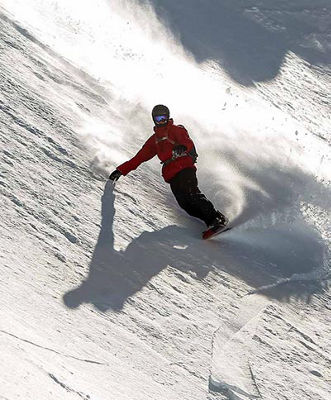BACKCOUNTRY
The allure of backcountry skiing and riding has increased over the last few years and many resorts, as well as manufacturers, are filling this demand with innovative products and services. Gathered below are resources to guides, training, gear, and bulletins to make help make your adventure safe and prepare you for avalanche and glacier hazards.
Access , opens in a new window
Access to Garibaldi Provincial Park from the valley is via Singing Pass trail on Whistler, and Blackcomb Bench Climb, North and South Routes on Blackcomb.
Check the Terrain Status Map for up-to-date alpine access to the backcountry on Whistler or Blackcomb. For all lift & terrain updates, follow our social channels including WBMtnOps, check the My Epic App and our Lift & Terrain Status page.
Play safe in the snow.
Backcountry Avalanche Advisory , opens in a new window
Three day avalanche hazard forecast prepared for the Sea to Sky region, this region includes the backcountry terrain outside of the Whistler Blackcomb boundaries.
TERRAIN STATUS GIS MAP , opens in a new window
Our winter GIS map was created as an additional tool for backcountry users to view terrain zones and uphill route live status to help plan your access to and from Garibaldi and Blackcomb Glacier Provincial Parks.

Backcountry Tickets
- Backcountry tickets are available daily through winter operations, with exceptions during extreme weather events. Whistler Blackcomb will assess conditions, hazards and mountain access during extreme weather events, and may stop backcountry ticket sales during extreme weather events.
- Proper gear is required to purchase ticket. Skis, snowboard or split board are required as well as; an avalanche transceiver and demonstrated ability to use it, probe, shovel, skins, cell phone.
- Tickets are sold for a specific lift set to reach the backcountry access points and cannot be used on other lifts.
- Opening of lifts and routes are dependent on weather, avalanche conditions and other public safety considerations. Please advised that not all lifts may be operational and not all routes may be open. Terrain and Lift status is updated on wb.com and the Epic Mix app. Respect terrain closures, if in doubt, check with Patrol.
- Guests must sign the Backcountry Access Agreement.
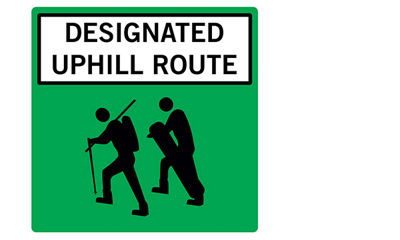
Uphill Travel
Uphill travel within the Whistler Blackcomb ski area boundary is only permitted on designated routes marked with signage. Please respect all on-mountain signage.
Lift Routes
Whistler Mountain
Big Red Express
Peak or Harmony Express
*Harmony or Emerald Express - access return to Creekside
Peak or Harmony Express
Garbonzo Express
Big Red or Emerald Express
Peak or Harmony Express
Blackcomb Mountain
Glacier Express or Seventh Heaven Express
Showcase T-Bar
Excelerator Express
Glacier Express
Showcase T-Bar
Excelerator Express
Jersey Cream Express
Seventh Heaven
Accessing Garibaldi Provincial Park
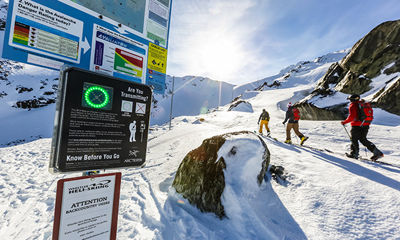
Starting on Whistler Mountain
Please use the Whistler Map contained below to follow our designated route on Whistler Mountain to Garibaldi Provincial Park. Please note:
- The route marked in yellow is Singing Pass. This is the route from the valley bottom to the park boundary. It is an All Weather Conditions route.
- The route marked in orange is Oboe Traverse. This is also an All Weather Conditions route. Skiers and splitboarders will need a lift ticket to access the bottom of the route as it begins inbounds
- Garibaldi Park access by snowshoe is via Singing Pass only.
Starting on Blackcomb Mountain
Please use the Blackcomb Map contained below to follow our designated route on Blackcomb Mountain to Garibaldi Provincial Park. Please note:
- Blackcomb Bench Climb - The lower mountain access route marked in yellow on the map, an All Weather Conditions route that leads to three upper route options. The Blackcomb Bench Climb is an unmaintained winter route. This route is signed with the green uphill route sign shown above. Begins either on skier’s right of Merlin’s ski run or from Lot 7, the main trailhead sign is located on the North side of Lower Cruiser at Base II.
- Excelerator Connector - Marked in orange on the map, an All Weather Conditions route that makes the short connection to Excelerator. This route is an unmaintained winter route. Skiers and riders will need a valid lift ticket or pass to access the lift system.
- Crystal Exit – Provides two way access between the North Route and the bottom station of Crystal Express.
GARIBALDI PROVINCIAL PARK ACCESS:
- North Route - Upper route marked in yellow on the map. An All Weather Conditions route that travels through the forest outside of the Ski Area Boundary leading to Garibaldi Provincial Park. The North Route is an unmaintained winter route. The North Route is marked with blue flagging tape, navigation skills are required (maps, compass and/or GPS and skills to use these tools). Check the Terrain Status Map for up to date avalanche conditions and terrain closures before re-entering the Ski Area Boundary.
DOWNLOAD THE GPS TRACK ON TRAILFORKS >
- South Route (Interim Route - Time Restricted) - The route marked in turquoise will take skiers and splitboarders up Blackcomb to the park boundary. This route is signed with the green uphill route sign shown above. This is an All Weather Conditions route and open only from 5am to 9:30am. You must be clear to the bottom of Seventh Heaven by 9:30am.
DOWNLOAD THE GPS TRACK ON TRAILFORKS >
- East Col - Marked in pink. Accesses the park from beyond Blackcomb Glacier. This route requires a lift ticket and high alpine clearance. Check the Terrain Status Map to find out if the route is open. Recheck the map the morning of your trip and immediately before leaving. This map is updated by Patrol as conditions change.
- Snowshoe Route - Garibaldi Park access by snowshoe is via the Blackcomb Bench Climb and the North Route only. Snowshoes can ascend and descend on these two designated routes. Please respect the multi-use trails, by staying off of the skin track.
When the high alpine lifts are closed due to avalanche danger, backcountry skiers and snowboarders should check the Terrain Status Map for more information on how to safely access the backcountry. Backcountry access route status is also available on Epic Mix and on our Terrain and Lift Status page.
Re-entering the Ski Area Boundary
Skiers and snowboarders looking to re-enter Whistler Blackcomb’s ski area boundaries from the backcountry should check the Terrain Status Map for up-to-date avalanche conditions and terrain closures within the ski area boundary. When re-entering the ski area boundary after hours please be aware of operational hazards such as grooming cats, snowmobiles, winch cats and to adhere to all signage and fencing.
If you encounter a winch cat sign when travelling through the ski area, make contact with the driver before proceeding past the equipment.

Winch Cat Working
If you encounter a winch cat sign when travelling through the ski area after hours, please make contact with the driver before proceeding past the equipment.
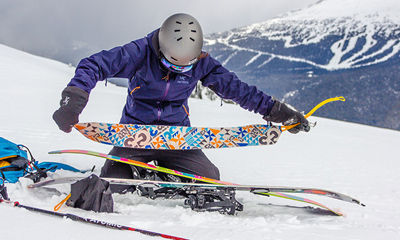
Backcountry Essentials
Every member of your group needs to be wearing a transceiver and have knowledge on how to use it. We recommend you take a course and / or hire a certified ACMG guide via Extremely Canadian.
Additionally, all members must carry an avalanche probe and a shovel. Once you've got the basics covered, the additional equipment list gets a little fun.
Please see the backcountry resources on Avalanche Canada and ensure you are prepared to go into the backcountry. You can find these resources here.


